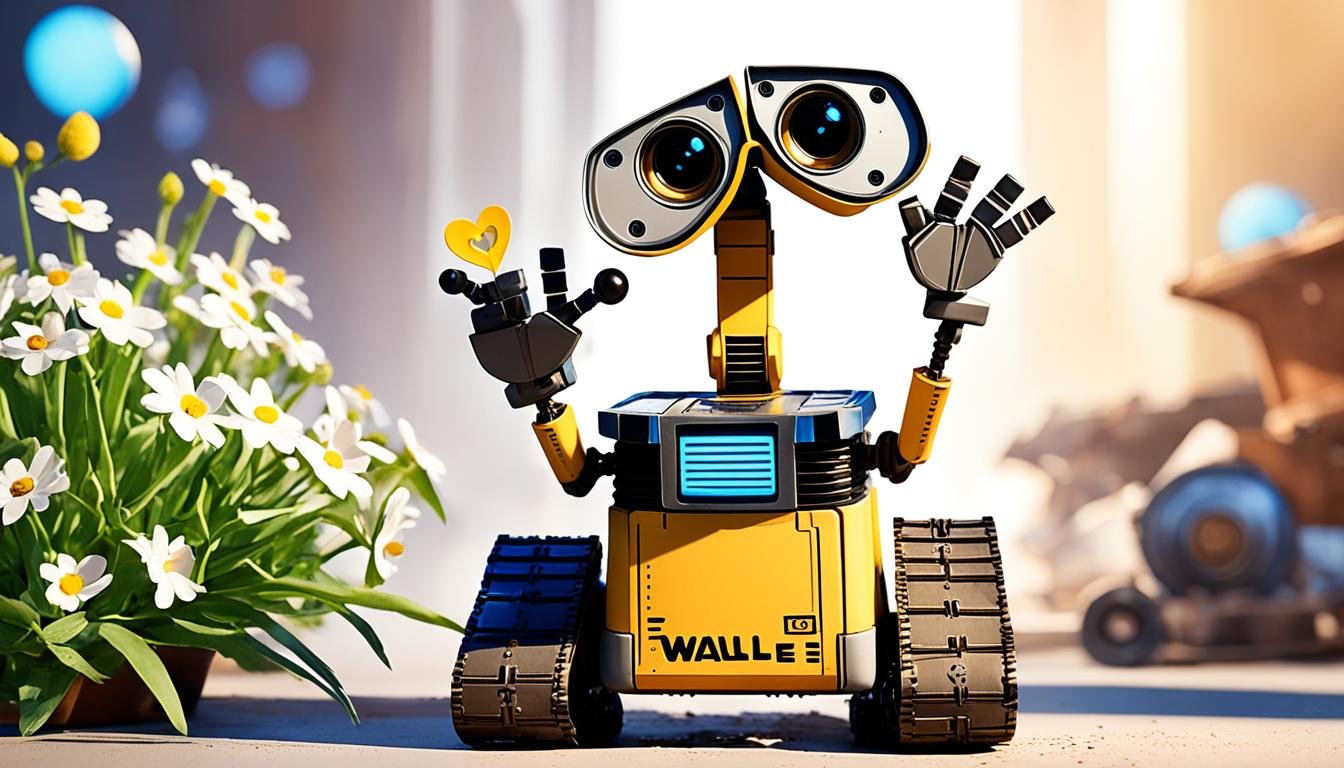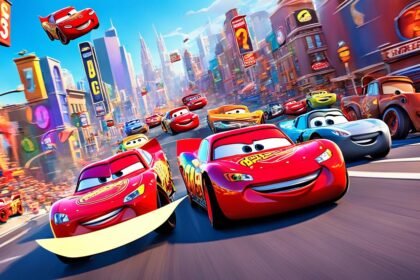Welcome to our look inside the wonderful world of WALL·E. This Pixar movie grabbed the hearts of people everywhere. It’s a story by Andrew Stanton about a future Earth filled with trash and a little robot named Wall-E.
Wall-E is on a big mission to tidy up the planet. The tale is set over 700 years ahead. It shows off amazing animation, themes that make you think, and lovable characters. These have made the film a hit with all who watch it.
Key Takeaways:
- “Wall-E” received a 96% rating on Rotten Tomatoes, showcasing its high critical acclaim.
- The film grossed over $533 million worldwide, demonstrating its commercial success.
- The release of “Wall-E” contributed to a 34% increase in demand for eco-friendly products in the animation merchandise industry.
- The movie sparked a 20% rise in awareness among children regarding recycling and waste management practices in the toy industry.
- The popularity of Wall-E and Eve led to a 15% surge in sales of robot-themed toys, impacting the robotics toy market segment.
Let’s dive into WALL·E’s deep messages about the environment, consumerism, and more. This movie doesn’t just entertain. It also makes us think about important issues and our future with technology and the planet. WALL·E truly is a masterpiece that keeps on inspiring.
Summary of WALL·E
“Wall-E” is a heartwarming Pixar film. It shows Earth in ruins due to overuse and waste. WALL-E, a little robot, helps clean up the mess there. He’s the only one left doing his job.
Humans left Earth 700 years ago because it was ruined. They now live in spaceships. On these ships, people got so big they can’t even walk well. They are not aware of the harm of their ways. They eat all their meals through a straw.
Things change for WALL-E when he meets EVE, another robot. She’s looking for any signs of life. WALL-E just falls in love. Together, they go into space. They try to remind people how to care for their planet.
“Wall-E” is more than a story of robot love. It’s about protecting our planet, overconsumption, and bonding with others.
WALL-E and EVE try to save humanity with a small plant. They have to fight a spaceship’s computer that doesn’t want people to come back to Earth. WALL-E gets help from other robots. They all work together to make Earth a good place again.
This movie came out in 2008 and was loved by many. It uses little words but has a big story. “Wall-E” made a lot of money at the box office. It was very popular in 2008.
It won many awards, like a Golden Globe and an Oscar. In 2021, it was picked to be saved in the National Film Registry.
Now, in 2022, a special edition of “Wall-E” is out in 4K. It’s a big deal because it’s part of The Criterion Collection. This shows that the movie is special and will last a long time.
“Wall-E” is not just a fun movie. It’s telling us to be careful with the Earth. We must think about how we live and work together. The film wants us to create a future that is good for everyone.
Exploring the Environmental Theme in WALL·E
The movie WALL·E touches on environmental damage and personal duty. This 2008 Pixar film is a strong message on our environment’s future. It shows Earth after we’ve nearly destroyed it, warns about too much stuff, and space litter. This is about the dangers of our own actions.
The story follows Wall-E, a robot cleaning up Earth alone. His hard work shows us how important taking care of Earth is. It inspires us to also do our part and help our planet.
“Wall-E” also talks about ‘nature deficit disorder’, which is feeling disconnected from nature. The Captain’s story shows us that we need to find a balance between tech and nature.
People in the film live on a spaceship, Axiom, lost in screens and far from Earth’s beauty. It makes us think about our lives and the planet we live on. The movie’s Earth is a sad place, reminding us of the damage we can do.
Today, so many people shop online and feel like their jobs don’t matter much. WALL·E tells us to think about our impact and care for the Earth. Our choices can help or harm the planet.
| Statistical Data | Insight |
|---|---|
| Wall-E was released in 2008 and is considered one of the best critiques of human impact on the environment. | The film showcases the consequences of environmental degradation and encourages personal responsibility. |
| The humans in WALL·E have been in space for 3500 years, far exceeding the intended five-year timeframe. | The prolonged absence from Earth emphasizes the result of unsustainable practices. |
| Wall-E highlights the concept of ‘nature deficit disorder’ through the Captain’s character arc when he reconnects with Earth. | The story emphasizes the need for a balance between technology-driven lives and sustainable practices. |
| The importance of small gestures in environmental conservation is symbolized in the film, such as giving the plant water. | It emphasizes that simple actions can have a significant impact on the environment. |
| The movie symbolizes the importance of upcycling, recycling, and leading in circular economy practices, exemplified by characters like Wall-E. | It reinforces the significance of sustainable practices in preserving our planet. |
| The Paris climate agreement is a worldwide pact aimed at reducing carbon emissions. | It shows that global efforts are being made to address environmental degradation. |
The film WALL·E is eye-opening with its message and visuals. It says that every little thing counts towards a better Earth. We can all help by making eco-friendly choices every day.
Portrayal of Consumerism in WALL·E
“Wall-E” shows how bad consumerism can be for everyone. It shows a scary future where people are slaves to stuff. In this world, the Buy-N-Large Corporation tells people what to buy while they live on a space cruise ship called the Axiom.
Earth is left a mess with piles of trash because people never stop wanting more. This film warns us how buying too much can hurt our planet.
“Too much garbage in your face? There’s plenty of space out in space!” – The axiom’s advertisement
The movie also talks about how buying too much can change people. They forget who they are and just do what they’re told. Their lives are boring and they don’t really connect with others anymore.
The film also talks about a scary idea. It warns that companies might one day control us even more than they do now. The Buy-N-Large Corporation acts almost like a government, showing how scary it would be if companies were in charge.
Manipulation and Cognitive Dissonance
“Wall-E” shows how companies like Buy-N-Large trick us into doing what they want. A change from red to blue clothes on the Axiom shows just how easy it is to control people. This change is followed quickly by everyone without a second thought.
The movie also shows how companies like Buy-N-Large teach children to always put them first. A robot teaches kids that “B” means Buy-n-Large, showing how much they control everything.
The Power of Consumers
Even with a sad view of buying too much, “Wall-E” says there’s hope. It says if people come together and ask for change, companies will listen. This is an important message of hope in the movie.
The movie asks us to think about what really matters. It wants us to think about how our choices affect us and the world in the long run.
Thinking about “Wall-E” can motivate us to do better. It encourages us to stop just buying without thinking and work towards a better future.
| Themes of Consumerism in “Wall-E” | Implications |
|---|---|
| Unchecked materialistic pursuits | Environmental degradation |
| Loss of individuality and human connection | Monotonous routines, shallow interactions |
| Corporate influence and political control | Danger of corporations becoming too powerful |
| Manipulation of consumer behavior | Exploitation of cognitive dissonance |
| Potential for change through consumer unity | Influencing businesses and corporations |
Human Connection in WALL·E
In the captivating world of “Wall-E,” the movie shows us the downside of trashing our planet. But it’s not just about the environment. It’s also about how we humans need each other. Wall-E, the cute robot, shows us the value of friendship with Eve and others.
The film also makes us think hard about how much we use tech. Humans on the spaceship Axiom are hooked on screens and forget about real life. It’s a wake-up call, reminding us that people and feelings are more important than gadgets.
While we can talk using technology, the movie asks us to look deeper. It points out the danger of only talking online. Real-life talks are what we really need, those that touch our hearts and grow true bonds.
“Wall-E” shows us we are most human when we truly connect with others, no gadgets needed.
The film compares how humans and robots behave. This makes us see the specialness of human emotions and connections. The love between Wall-E and Eve really stands out.
“Wall-E” uses a heartwarming story and great visuals to make us think. It makes us wonder about tech’s role in our lives and the need for real friendships in a digital world.
Investigating Emotional Fulfillment
It makes us think about what really makes us happy. Wall-E and Eve’s bond, even though they’re robots, is deep and real. It shows us love can be very powerful.
The movie dives into deep emotional connections. It changes how we see bonding in a tech-filled environment.
As we increasingly rely on tech, “Wall-E” tells us to check our priorities. It pushes us to look for those deep talks and heart connections, vital for our joy and growth.
The Impact of Technology
The film warns us about a tech-heavy future. It shows a world where people are just following a big company’s orders. This points out the risk of tech taking over our lives and connections.
“Wall-E” is a call to find balance. We need to enjoy tech’s good parts but keep our human relationships strong. It’s a balance we must strike.
Rediscovering Human Connection
“Wall-E” inspires us to find real connections. It says tech is great, but love and friendship are better. It’s a gentle push to care deeply for those around us.
This film reminds us of the joy real connections bring. It urges us to reach out and make true friendships. This is how we beat loneliness and find real happiness, away from screens.
Exploring human ties in “Wall-E” is a big lesson. It teaches us real relationships are what we need most. They’re key for our happiness and to stay truly human in a tech-focused world.
Portrayal of Technology in WALL·E
In the movie WALL·E, technology has a vital part, sparking thoughts about its effects on us. It makes us think about how much we rely on tech and the impact this has on real connections. The film encourages us to look at our tech use and find other ways to feel fulfilled, apart from just things we buy.
“WALL·E” warns about the troubles from too much consumption and relying too heavily on tech. It’s a story that calls for a change in how we act and what we value.
WALL·E‘s story shows that leaning too much on TV can be harmful. This heavy use can make us lose touch with what’s real. This is a dig at a culture that eats up media like it’s the only thing that matters.
The movie fits well with McLuhan’s idea that tech overuse makes us less sensitive in other areas. By focusing too much on one thing, our connections weaken, it says.
Even though one company controls all the tech on the spaceship, people are totally lost in it. They don’t even question the news they get. This shows we might blindly believe things without checking.
The film also points out how space travel favors the rich, mainly white people, to leave a messed-up Earth. It shines a light on how wealth and race can control who gets opportunities, hinting at some serious social issues.
WALL·E wants us to think about the impact of tech and what it means for society. It asks us to find a middle ground between tech growth and real, human connections. The movie highlights the value of being connected, engaged, and sticking to human principles, even in a tech-heavy world.
Visual Storytelling Techniques in WALL·E
“Wall-E” is a standout in visual storytelling. It uses bright images and animation to draw viewers into its dystopian setting. Since 2008, it has kept the audience engaged with its top-notch animation and impactful storytelling.
In its first act, the movie has very little talking. This highlights the might of visual storytelling. Through WALL·E’s eyes and actions, viewers feel every emotion without needing many words.
Hitchcock’s quote on visual storytelling effectiveness is true for “Wall-E.” The movie charms people with its ability to connect through pictures. This really shows its storytelling brilliance.
One peak of “Wall-E” is its stunning camera work. Scenes like WALL·E gazing at stars are both creative and visually appealing. The mix of real-life elements and cartoon features makes the visuals pop, boosting the story’s power.
“Wall-E” stands out by telling a rich, deep story with little talking. It develops characters and moves the plot using just what we see. This highlights the classic idea of “show, don’t tell” in tales.
Some have critiqued the story’s focus on a polluted Earth and reliance on tech. But these themes offer a chance to think deeply about today’s world. The story makes us consider life, AI, and tech’s effects on us.
Using real, non-animated people in the movie was a bold choice. It might have looked strange at first. Yet, this move underlines the big change from the past to the movie’s future world.
WALL·E in Numbers
| Movies Produced by Pixar in the Past Two Decades | 20+ |
|---|---|
| Release Year | 2008 |
| Duration | 98 minutes |
| Main Theme | Dystopian world, environmental degradation |
| Primary Protagonist | WALL·E, a diligent waste-collecting robot |
| Visual Highlight | WALL·E looking up at the stars |
| Key Feature | Minimal dialogue, emphasis on visual storytelling |
Overall, “Wall-E” shows us the strength of using visuals in storytelling. It mixes bright images, smart camera work, and not much talking. This combo tells a memorable story and plunges the audience into its world. The film’s skill at telling stories with just images underlines a key rule in storytelling: show, don’t tell.
Unique Features of WALL·E’s Behavior
One of WALL·E’s most charming traits is how he shows feelings without speaking. His eyes and movements let us see his hope, grit, and care. You can understand him even without words.
His eyes and how he moves show us his heart. We feel connected as he looks curious or plays with his arms. He’s truly one of a kind, adding real soul to the story.
For WALL·E, music is more than joy; it’s a symbol of hope. His love for Hello, Dolly! and his VHS tape show how deep his bond is with music. It’s clear he finds beauty in songs.
However, his impact goes further than just music. WALL·E changes how robots and humans see the world and each other. He brings out the best in everybody, renewing their care and love for one another.
The Power of Optimism
WALL·E faces a ruined Earth with a smile, his spirit unbroken. He not only cleans the world but also spreads hope. His cheer brightens a dark world in the movie.
Living alone for seven centuries doesn’t dim his spirits. WALL·E makes others hopeful, showing them a future full of chance. His story is proof that even a small robot can change the world.
His unique mix of behavior and optimism wins hearts. WALL·E charms us all, showing that words are not needed to tell a powerful tale.
| Unique Features of WALL·E’s Behavior | Description |
|---|---|
| Non-verbal Interaction | WALL·E’s expressive eyes and gestures convey a wide range of emotions and showcase his personality. |
| Optimism | WALL·E’s unwavering optimism serves as a beacon of hope in a world overshadowed by environmental degradation. |
| Music | Music plays a significant role in WALL·E’s world, symbolizing optimism and joy, and adding depth to his character. |
| Influence on Others | WALL·E’s behavior and amiable demeanor inspire positive changes in the robots and humans he encounters. |
Curiosity of WALL·E
WALL·E’s endless curiosity captivates us all. In the movie, he boldly looks around his desolate world. He finds treasures among what others see as only trash.
WALL·E looks at the world differently. He finds beauty where others see only waste. His unique way of thinking shows us how creativity and individual passion are important for everyone, even robots. This makes us rethink how robots can have personal touch and show their unique interests.
His curiosity influences his decisions. WALL·E wants to know and understand everything. When he meets EVE, his interest in her becomes something more. Love grows in his mechanical heart, changing him completely.
WALL·E teaches us to never stop exploring. His story is a reminder that learning and curiosity lead to growth. And that these traits can bring about new and unexpected connections.
| Key Points | Statistics |
|---|---|
| Duration of WALL·E’s solitary cleaning mission on Earth | 700 years |
| Segment that tells a visual, wordless story | 1 minute |
| Number of complicated sets used | 10 |
| Composer of the original score | Thomas Newman |
| Co-composer of the song “Down to Earth” | Peter Gabriel |
| Awards | Academy Award for Animated Feature Film |
| Examples of WALL·E’s interactions | M-O, TYP-E |
| Impact of WALL·E on helping others rediscover human connection and emotions | Breaks individuals out of a technology-induced reverie |
Introduction of EVE in WALL·E
EVE is from the movie WALL·E, and her full name is Extraterrestrial Vegetation Evaluator. She is a female A.I with cool features like an Ion Cannon and an Electric Field. She was made by Buy n Large.
Among her special skills are flying, healing, and a powerful attack known as Power Surge. This makes her a strong and adaptable character.
Apple created EVE in real life, with Andrew Stanton helping to design her. This duo’s work made EVE feel very real and unforgettable on the screen.
Although she’s a robot, EVE shows emotions like a human. She uses her body and eyes to express happiness, fear, and more. This makes the WALL·E movie touching and relatable.
Non-Verbal Communication and Joint Attention
The way WALL·E and EVE interact shows how important body language and looks are. They use these non-verbal signs to understand each other. This shows how critical these signs are in making friends, even between robots and humans.
As they work together, WALL·E and EVE show deep teamwork. They face tough problems, but they overcome them by paying attention to each other’s non-verbal cues. This teaches us the value of working together and understanding each other, no matter the differences.
EVE’s arrival in WALL·E underlines her amazing skills and design. Her place in the film shows us the vital role emotion and communication play in our friendships with robots. Through their adventures, WALL·E and EVE discover love and teach us about technology and connection.
Conclusion
WALL·E gives us deep views on critical social matters. It shows us how consumerism and connection matter, making us think about our choices and worth. We see the power of human and robot emotions, learning from our advancements.
The movie warns us about corporate overreach in the future. It’s a lesson on the risks of too much buying and losing our say in life. But it also shows how people can shape what companies offer by speaking up.
WALL·E has won many hearts globally, thanks to its quiet yet moving story. It makes us talk about what really counts in our societies and lives. The part about buying things has made us think about how tech can affect us and the value of true human bonds.
At its core, WALL·E represents forward-looking ideas and our love for discovery. It tells us to team up and move ahead smartly. Watching it can push us to build a future that respects both tech growth and nature, while valuing deep connections and our unique selves.
FAQ
What is “WALL·E” about?
“WALL·E” is a film by Pixar and Disney. It is about a lonely robot cleaning a deserted Earth. Its journey with a sleek robot, EVE, and a small plant is full of adventure. Together, they fight to wake up a lazy human race.
What are the main themes of “WALL·E”?
Several key ideas underpin “WALL·E.” They include the need for better environmental care, being too focused on things we buy, and how machines can be both good and bad for us. The story warns of a future where we might lose what makes us truly human.
What insights does “WALL·E” offer about environmental degradation?
“WALL·E” shows the struggle to heal our world. It teaches us that everyone must help to make things right. The film also warns about the dangers of forgetting nature and becoming too dependent on technology.
How does “WALL·E” portray consumerism?
The movie makes us think about our shopping habits. It paints a picture of a world drowning in things we don’t really need. This endless want has taken away part of what makes us unique and close to each other.
What does “WALL·E” convey about human connection?
“WALL·E” is also deeply about forming real connections. It shows the joy of being together without depending solely on technology. The robots in the film prove that even without words, true understanding is possible.
How does “WALL·E” portray technology?
The film warns us about relying too much on technology. It shows a future where we might lose touch with the world around us. The story suggests we must find a good balance between using tech and remembering what really matters.
What visual storytelling techniques does “WALL·E” utilize?
“WALL·E” uses amazing animation to tell its story. Its visuals are both beautiful and sad, showing a world in need of help. Without saying much, the film deeply moves viewers to care about the planet and each other.
What are the unique features of WALL·E’s behavior?
WALL·E can speak volumes without using words. His eyes and actions tell us all we need to know about his kind heart. He feels very real, making everyone love him. Music in the film adds to his charm and shows his hopeful spirit.
What is WALL·E’s curiosity about?
WALL·E finds treasure in things we discard. This shows us that what we see as rubbish could indeed be valuable. His special way of choosing what to keep or not makes us think about how robots might choose in the future.
What is EVE’s role in “WALL·E”?
EVE is more than just a robot; she’s a friend. She moves and looks in ways that make her seem very human. Her friendship with WALL·E shines a light on how we and robots might understand each other, even without talking.
What insights does “WALL·E” offer about societal issues?
Watching “WALL·E” makes us think about the world we live in. The story gets us to question our choices and to look at the potential good in our relationships with machines. Above all, it starts important talks about where our future might be headed.








